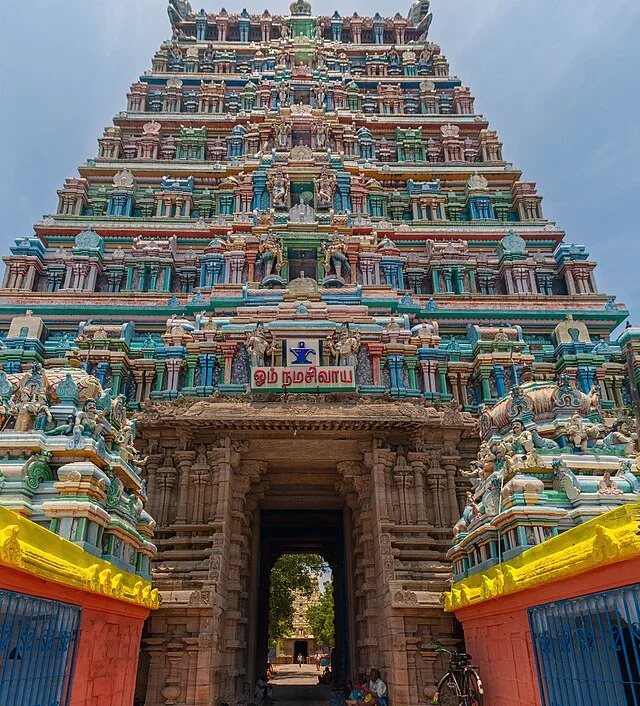The Uthirakosamangai Shiva Temple is an ancient Hindu temple located in the Tamil Nadu state of India. It is dedicated to Lord Shiva and is a prominent pilgrimage site for devotees of the Shaiva tradition. The temple has a long history, with references to its existence found in early Tamil literature and inscriptions. It is considered one of the 275 Paadal Petra Sthalams, sacred temples praised in the Tamil hymns of Nayanmars.
Get your dose of History via Email
Historical Significance
The Uthirakosamangai Shiva Temple has historical importance dating back to at least the 7th century AD. The temple is mentioned in the hymns of the Nayanmar saints, who lived during the Sangam period (circa 3rd century BC to 3rd century AD). These hymns, known as the Tevaram, were composed by the four prominent Nayanmars—Tirugnanasambandar, Tirunavukkarasar, Sundarar, and Manickavacakar.
Inscriptions in the temple and surrounding areas suggest that it was patronized by various Tamil kings, particularly from the Pandya dynasty. The temple flourished during the reign of the Pandya kings, especially during the 8th to 9th centuries AD.
Architecture and Layout
The Uthirakosamangai Shiva Temple features classic Dravidian architecture, characterized by intricately carved pillars, large gopurams (gateway towers), and spacious courtyards. The temple complex is surrounded by a high boundary wall, which encloses the sanctum, hall, and other smaller shrines.
The main shrine houses a large Shiva Lingam, the principal object of worship. A notable feature of the temple is the presence of a unique stone-carved Nandi (bull), which is a common feature in Shiva temples, positioned near the sanctum.
The temple also has several smaller shrines dedicated to other deities of the Hindu pantheon, including Lord Vishnu and Goddess Parvati. These shrines are part of the larger temple complex, which includes several halls for worship and gatherings.
The Legend of Uthirakosamangai
The temple is associated with the legend of the cosmic dance of Lord Shiva. According to the myth, Lord Shiva, in his form as Nataraja, performed the cosmic dance at this location, and this event is said to have occurred in Uthirakosamangai. This divine dance symbolizes the creation, preservation, and destruction of the universe.
Another legend states that the temple was originally a small shrine that was later expanded by the Pandya rulers. Over time, the temple became a significant center for Shaiva worship and attracted pilgrims from various parts of India.
Rituals and Festivals
The Uthirakosamangai Shiva Temple is a hub for religious activities, with daily rituals and annual festivals drawing large crowds of devotees. The temple conducts regular prayers, abhishekams (ritualistic bathing of the deity), and other religious ceremonies.
One of the major festivals celebrated at the temple is the Maha Shivaratri, which occurs annually in honor of Lord Shiva. This festival, which falls in the Tamil month of Maasi (February-March), is observed with great enthusiasm. Pilgrims visit the temple to participate in night-long vigils, prayers, and rituals.
Other important festivals include the Panguni Uthiram, which celebrates the divine marriage of Lord Shiva and Goddess Parvati, and the Navaratri festival, dedicated to the worship of Goddess Durga.
Preservation and Modern Significance
The Uthirakosamangai Shiva Temple remains an important religious and cultural landmark in Tamil Nadu. It continues to serve as a place of worship, attracting pilgrims from around the world. Despite modern challenges, the temple has been well-preserved through the efforts of the Tamil Nadu government and local communities.
The temple also serves as a center for the promotion of Tamil culture and religious traditions. It contributes to the local economy by drawing tourists and pilgrims, which supports the surrounding village and its inhabitants.
Conclusion
The Uthirakosamangai Shiva Temple stands as a testament to the rich religious and cultural history of Tamil Nadu. Its architectural beauty, historical significance, and association with various legends make it an essential part of India’s Hindu heritage. The temple continues to inspire devotion and draw worshippers from across the globe, preserving ancient traditions while adapting to the modern era.
Source:

